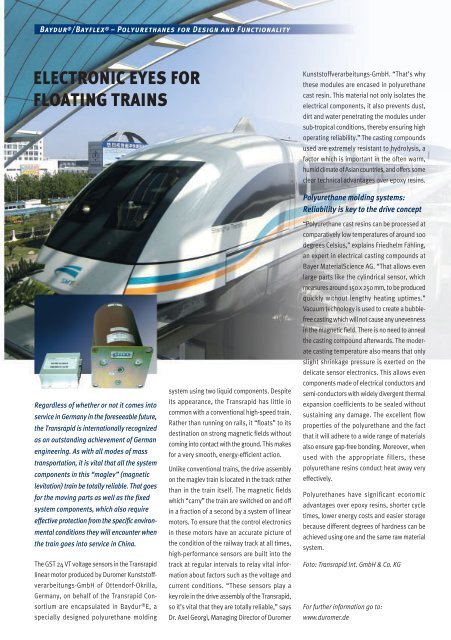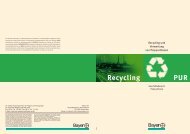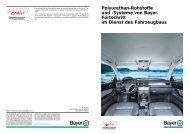Here - Polyurethanes - Bayer
Here - Polyurethanes - Bayer
Here - Polyurethanes - Bayer
You also want an ePaper? Increase the reach of your titles
YUMPU automatically turns print PDFs into web optimized ePapers that Google loves.
Baydur ®/Bayflex ® – <strong>Polyurethanes</strong> for Design and Functionality<br />
ELECTRONIC EYES FOR<br />
FLOATING TRAINS<br />
Regardless of whether or not it comes into<br />
service in Germany in the foreseeable future,<br />
the Transrapid is internationally recognized<br />
as an outstanding achievement of German<br />
engineering. As with all modes of mass<br />
transportation, it is vital that all the system<br />
components in this “maglev” (magnetic<br />
levitation) train be totally reliable. That goes<br />
for the moving parts as well as the fixed<br />
system components, which also require<br />
effective protection from the specific environmental<br />
conditions they will encounter when<br />
the train goes into service in China.<br />
The GST 24 VT voltage sensors in the Transrapid<br />
linear motor produced by Duromer Kunststoffverarbeitungs-GmbH<br />
of Ottendorf-Okrilla,<br />
Germany, on behalf of the Transrapid Consortium<br />
are encapsulated in Baydur ® E, a<br />
specially designed polyurethane molding<br />
system using two liquid components. Despite<br />
its appearance, the Transrapid has little in<br />
common with a conventional high-speed train.<br />
Rather than running on rails, it “floats” to its<br />
destination on strong magnetic fields without<br />
coming into contact with the ground. This makes<br />
for a very smooth, energy-efficient action.<br />
Unlike conventional trains, the drive assembly<br />
on the maglev train is located in the track rather<br />
than in the train itself. The magnetic fields<br />
which “carry” the train are switched on and off<br />
in a fraction of a second by a system of linear<br />
motors. To ensure that the control electronics<br />
in these motors have an accurate picture of<br />
the condition of the railway track at all times,<br />
high-performance sensors are built into the<br />
track at regular intervals to relay vital information<br />
about factors such as the voltage and<br />
current conditions. “These sensors play a<br />
key role in the drive assembly of the Transrapid,<br />
so it’s vital that they are totally reliable,” says<br />
Dr. Axel Georgi, Managing Director of Duromer<br />
Kunststoffverarbeitungs-GmbH. “That’s why<br />
these modules are encased in polyurethane<br />
cast resin. This material not only isolates the<br />
electrical components, it also prevents dust,<br />
dirt and water penetrating the modules under<br />
sub-tropical conditions, thereby ensuring high<br />
operating reliability.” The casting compounds<br />
used are extremely resistant to hydrolysis, a<br />
factor which is important in the often warm,<br />
humid climate of Asian countries, and offers some<br />
clear technical advantages over epoxy resins.<br />
Polyurethane molding systems:<br />
Reliability is key to the drive concept<br />
“Polyurethane cast resins can be processed at<br />
comparatively low temperatures of around 100<br />
degrees Celsius,” explains Friedhelm Fähling,<br />
an expert in electrical casting compounds at<br />
<strong>Bayer</strong> MaterialScience AG. “That allows even<br />
large parts like the cylindrical sensor, which<br />
measures around 150 x 250 mm, to be produced<br />
quickly without lengthy heating uptimes.”<br />
Vacuum technology is used to create a bubblefree<br />
casting which will not cause any unevenness<br />
in the magnetic field. There is no need to anneal<br />
the casting compound afterwards. The moderate<br />
casting temperature also means that only<br />
slight shrinkage pressure is exerted on the<br />
delicate sensor electronics. This allows even<br />
components made of electrical conductors and<br />
semi-conductors with widely divergent thermal<br />
expansion coefficients to be sealed without<br />
sustaining any damage. The excellent flow<br />
properties of the polyurethane and the fact<br />
that it will adhere to a wide range of materials<br />
also ensure gap-free bonding. Moreover, when<br />
used with the appropriate fillers, these<br />
polyurethane resins conduct heat away very<br />
effectively.<br />
<strong>Polyurethanes</strong> have significant economic<br />
advantages over epoxy resins, shorter cycle<br />
times, lower energy costs and easier storage<br />
because different degrees of hardness can be<br />
achieved using one and the same raw material<br />
system.<br />
Foto: Transrapid Int. GmbH & Co. KG<br />
For further information go to:<br />
www.duromer.de









